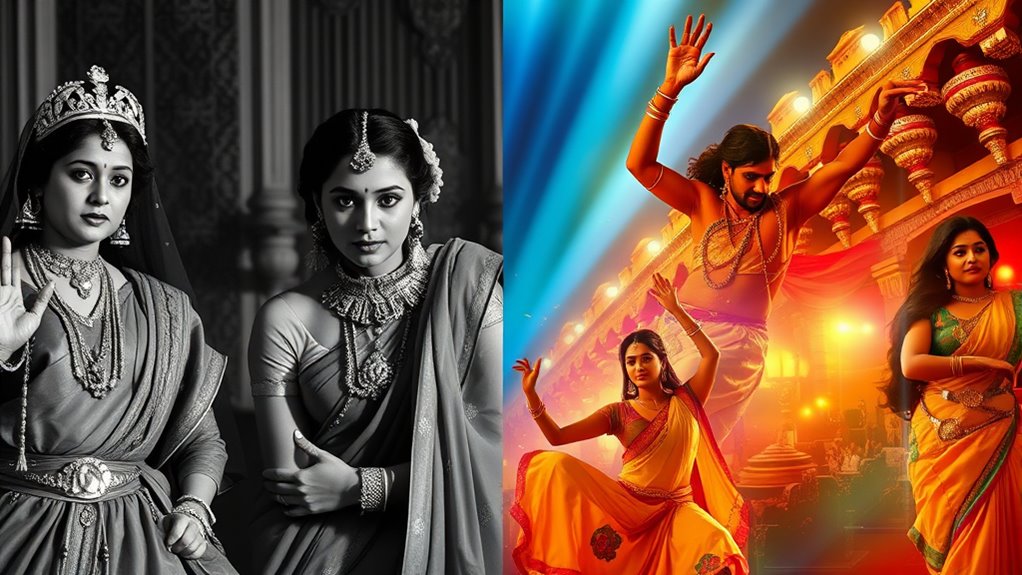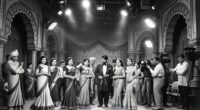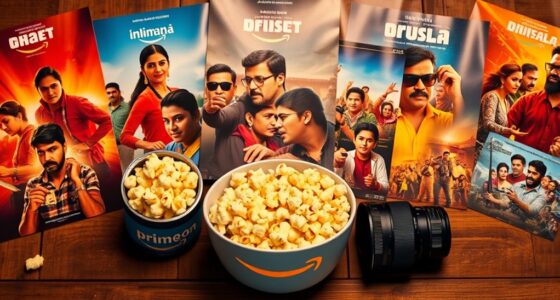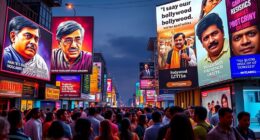Bollywood’s journey from silent films rooted in mythological stories to today’s big-budget blockbusters reflects a rich history of technological and artistic growth. You’ll see how early visual storytelling evolved with the advent of sound, allowing for more emotional and engaging narratives. Innovations in technology, global recognition, and new storytelling styles have continually shaped its vibrant industry. Stay with us to discover how Bollywood’s past influences its dynamic future.
Key Takeaways
- Bollywood evolved from silent films emphasizing visual storytelling to talkies with dialogue, music, and sound, transforming narrative depth and audience engagement.
- Technological innovations like sound synchronization, 3D, and digital effects revolutionized production quality and cinematic experiences.
- The industry expanded its genres and regional cinemas, reflecting India’s diverse culture and increasing global influence.
- Modern Bollywood integrates immersive technology, OTT platforms, and international collaborations, reaching audiences worldwide.
- The legacy of silent films established foundational visual techniques, shaping Bollywood’s storytelling and cultural significance today.
The Origins and Impact of Silent Films in India
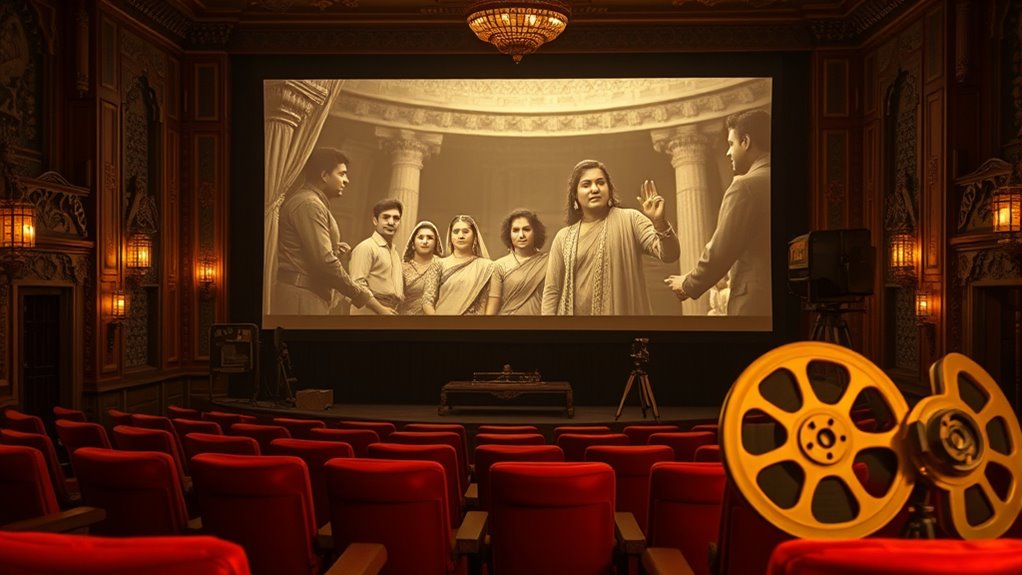
The origins of silent films in India date back to 1913 when Dadasaheb Phalke released *Raja Harishchandra*, marking the start of the country’s cinematic journey. You’ll find this film is considered the first Indian full-length silent feature, lasting about 50 minutes. Early silent movies often depicted mythological and historical stories, reflecting Indian society and culture. Influenced by foreign silent cinema, these films adapted narratives to Indian contexts, emphasizing expressive acting and visual storytelling. Without synchronized sound, filmmakers relied on visuals, intertitles, and live music or narration to convey stories. Acting skills were vital, as performers needed to express emotions clearly. This era laid the foundation for Indian cinema, fostering regional hubs and shaping cinematic language that still influences Indian films today. Silent films also played a crucial role in uniting diverse linguistic and cultural groups through universal visual storytelling. Additionally, the popularity of certain breeds and characters, like those in Paw Patrol, helped inspire a new generation of dog lovers and filmmakers alike. Furthermore, the use of visual storytelling techniques became a hallmark of silent cinema, establishing a narrative style that continues to influence filmmaking in India.
The Dawn of Sound and Its Influence on Indian Cinema
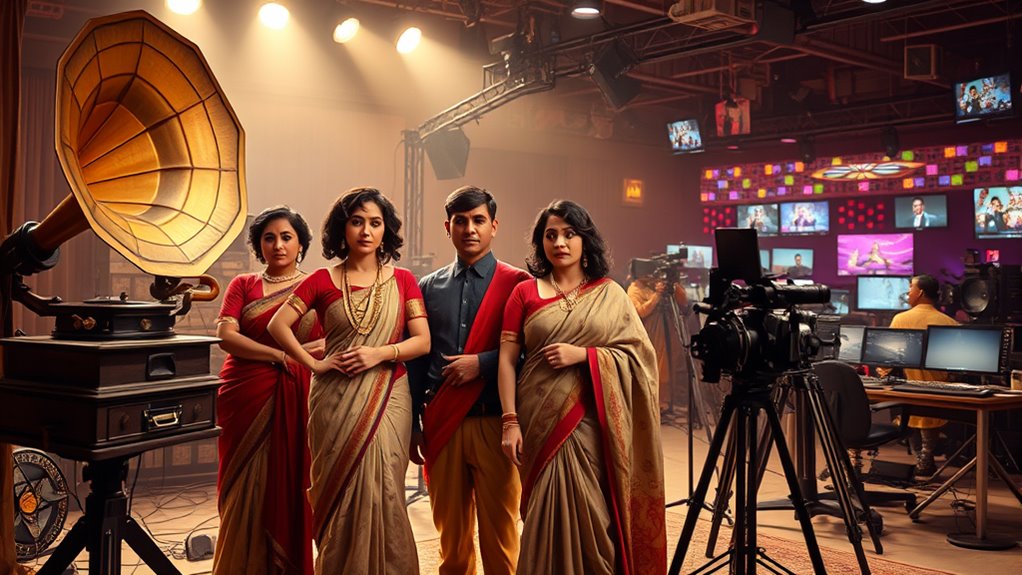
When sound was introduced to Indian cinema, it revolutionized storytelling and audience engagement. You see how technological breakthroughs like “Alam Ara” and early color films transformed the industry and expanded regional reach. This shift also brought cultural and artistic changes that still influence Bollywood today. The introduction of synchronized sound also led to the development of sound recording techniques that enhanced the overall cinematic experience. These innovations prompted a reevaluation of musical and vocal performances within Indian films, leading to the integration of playback singing and musical narratives. Additionally, the use of eco-friendly living practices, such as sustainable resource management, has become increasingly important in the film industry’s production processes, reflecting a broader societal shift toward environmental consciousness. The adoption of digital technology has further revolutionized filmmaking, enabling more sophisticated storytelling and visual effects. Ethical hacking techniques, such as penetration testing, have become integral in safeguarding these evolving digital assets against cyber threats.
Technological Breakthroughs in Sound
The introduction of sound in Indian cinema marked a revolutionary leap that transformed storytelling and production techniques overnight. You’d notice the impact with *Alam Ara* (1931), the first Indian talkie, which introduced synchronized dialogue and songs, changing how stories were told. This shift made films more engaging and commercially successful, prompting the rise of new studios like Bombay Talkies and Durga Cinetone. Technological advances, such as improved sound recording and synchronization, played a vital role. You’d see new soundproof studios and playback singing techniques, allowing actors to lip-sync prerecorded songs. This era also encouraged multilingual films, catering to India’s diverse audience. Overall, these breakthroughs laid the foundation for India’s vibrant sound-driven cinema, shaping its artistic and industrial growth. The development of sound design techniques, including field recording and digital sound synthesis, further enhanced the quality and richness of audio in films. Environmental considerations and sustainable practices also became increasingly important as the industry expanded.
Cultural and Artistic Shifts
The introduction of sound in Indian cinema didn’t just change how films were produced—it sparked a profound cultural and artistic transformation. You’ll notice storytelling became richer, with dialogue and music blending seamlessly to create more complex narratives and deepen character development. Audience engagement grew as films became more immersive, forging stronger emotional bonds. This transition also encouraged filmmakers to experiment with new genres and narrative techniques, broadening the scope of cinematic storytelling. The shift led to the rise of musicals like Indra Sabha, where song-and-dance became central to storytelling, and music took on cultural significance. Sound also expanded regional cinema, breaking linguistic barriers and fostering cultural exchange. Industry-wise, studios like Bombay Talkies emerged, and new talents gained prominence. Overall, sound revolutionized Indian cinema by blending art and culture, shaping the way stories reflected societal values and elevating cinema’s role as a powerful cultural mirror. Moreover, the advent of synchronized sound in 1931, exemplified by Alam Ara, marked a historic milestone that set the stage for the industry’s rapid growth and diversification. The technological innovation of sound in film production not only enhanced storytelling but also influenced other aspects of filmmaking, such as editing and sound design, further enriching the cinematic experience. Additionally, the integration of sound technology contributed to the development of regional dialects and languages, making films more accessible and relatable to diverse audiences.
The Golden Era: Innovation and Cultural Reflection
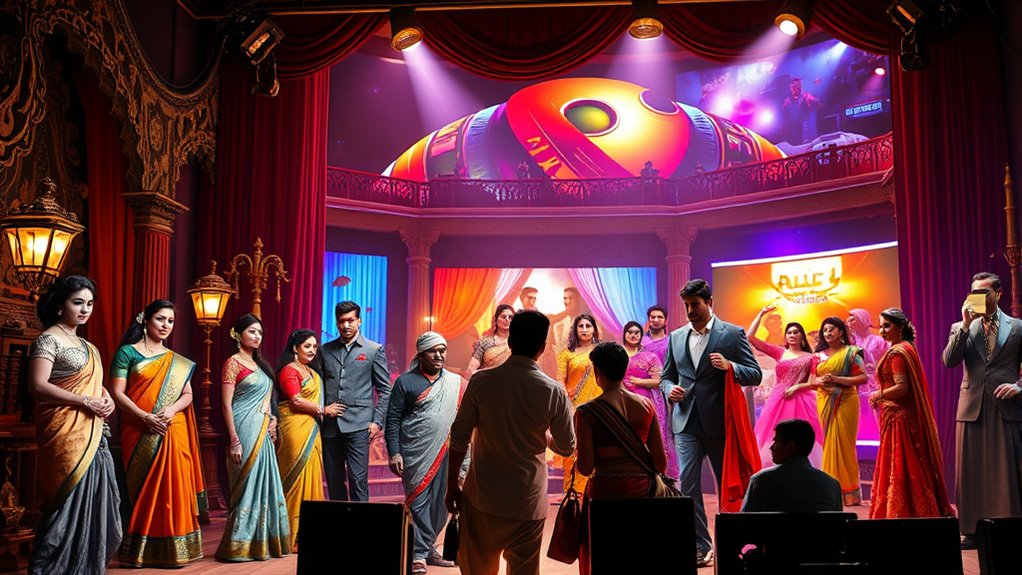
The Golden Era of Bollywood, spanning from the late 1940s to the early 1960s, marked a period of remarkable innovation in Indian cinema. You’ll notice filmmakers experimenting with new storytelling techniques and addressing social themes that reflected India’s changing society. This era produced critically acclaimed films like *Pyaasa*, *Mother India*, and *Mughal-e-Azam*, which showcased technical advancements and epic productions. You can see how films explored urban life, struggles of the working class, and national pride, shaping India’s cultural identity. Additionally, the era emphasized social themes such as urban struggles and social issues, further enriching the cinematic narrative. Understanding city dynamics was essential for filmmakers to authentically portray the evolving landscape of Indian society. Moreover, the influence of existential themes can be observed in characters’ introspective journeys, adding depth to storytelling during this transformative period. Furthermore, the incorporation of technological innovations contributed to the visual grandeur and narrative complexity of films during this era. The use of sound design also became more sophisticated, enhancing emotional impact and storytelling depth.
The Rise of Technological Advancements and Global Recognition
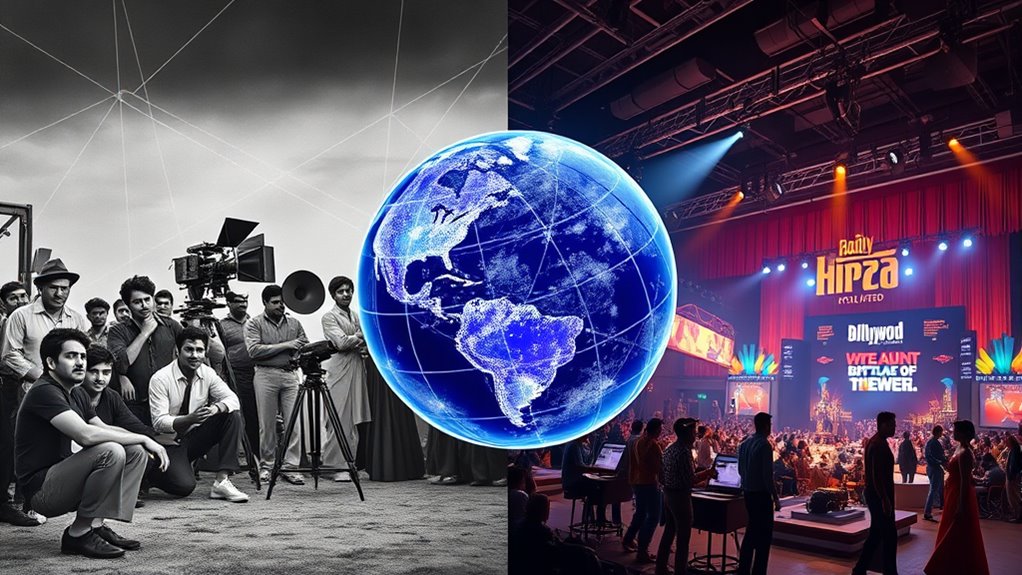
Technological advancements have transformed Bollywood from simple filmmaking to a hub of cutting-edge innovation, enabling it to gain international recognition. You now see how developments like high-tech labs in the 1970s improved film quality, while early computer graphics, starting with ‘Gentleman,’ pushed creative boundaries. The introduction of 3D films like ‘Chhota Chetan’ in 1984 attracted audiences and increased production output, making India a top film producer. Satellite TV and the internet expanded Bollywood’s reach globally, introducing new stars and storytelling styles. Films like ‘Lagaan’ and ‘The Lunchbox’ gained international acclaim, showcasing Indian stories to the world. Additionally, the adoption of Self Watering Plant Pots technology in film set design and production has contributed to more sustainable and efficient filming practices. The integration of asset division principles has also become important when managing the financial aspects of film production and distribution rights. Moreover, the incorporation of AI security measures can help protect valuable digital assets and intellectual property in the industry. Furthermore, the use of AI-powered analytics has enabled filmmakers to better understand audience preferences and tailor content accordingly.
Recent Trends Shaping Contemporary Bollywood
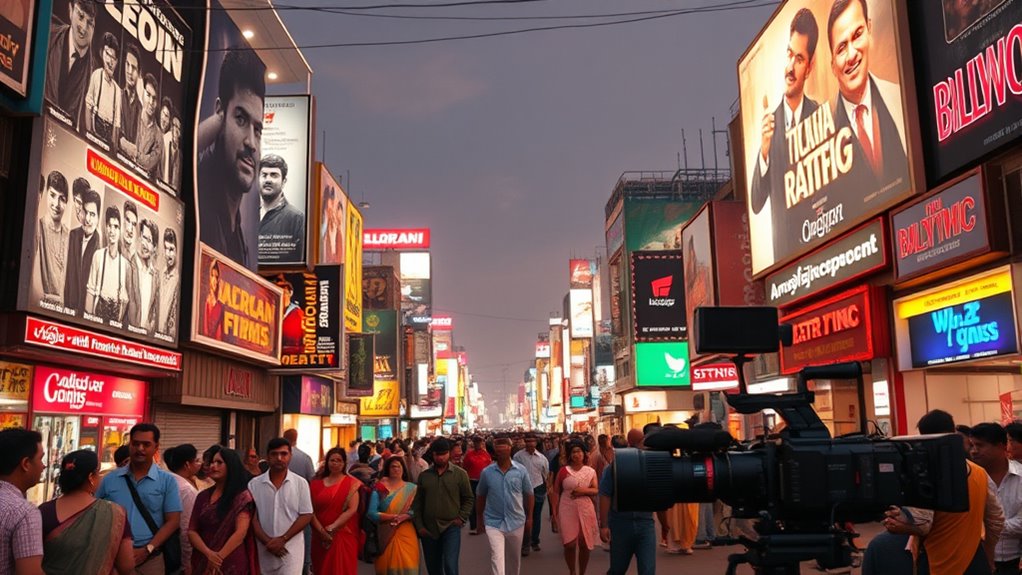
Recent trends are transforming Bollywood into a dynamic and immersive entertainment industry. Live music events now drive audience engagement, with over 30,000 concerts in 2024, fueling music tourism with nearly half a million fans traveling for concerts. Audiences crave multi-sensory experiences that blend music, food, and technology, making festivals and concerts a holistic cultural showcase. Content-wise, Bollywood shifts beyond traditional romances to include biographical, historical, and regional stories that reflect modern Indian realities. Its global influence surges through collaborations with international artists, festivals, and co-productions, boosting its worldwide reach. Meanwhile, digital platforms dominate, with OTT services surpassing TV, offering diverse regional and niche content. This shift emphasizes high-quality productions, strategic investments, and technological innovations focused on profitability and audience engagement. Proper use of visual effects and innovative storytelling techniques further enhance viewer experience and engagement. Additionally, the industry is increasingly adopting modern filmmaking techniques to stay competitive and appealing to a global audience. As the industry continues to evolve, understanding content strategy becomes essential for creators aiming to capture and retain audience interest worldwide. Moreover, integrating technological innovations, such as augmented reality and virtual reality, is opening new avenues for storytelling and viewer interaction. The adoption of new content formats is also playing a crucial role in attracting diverse audiences and keeping content fresh.
The Future Trajectory of Indian Filmmaking
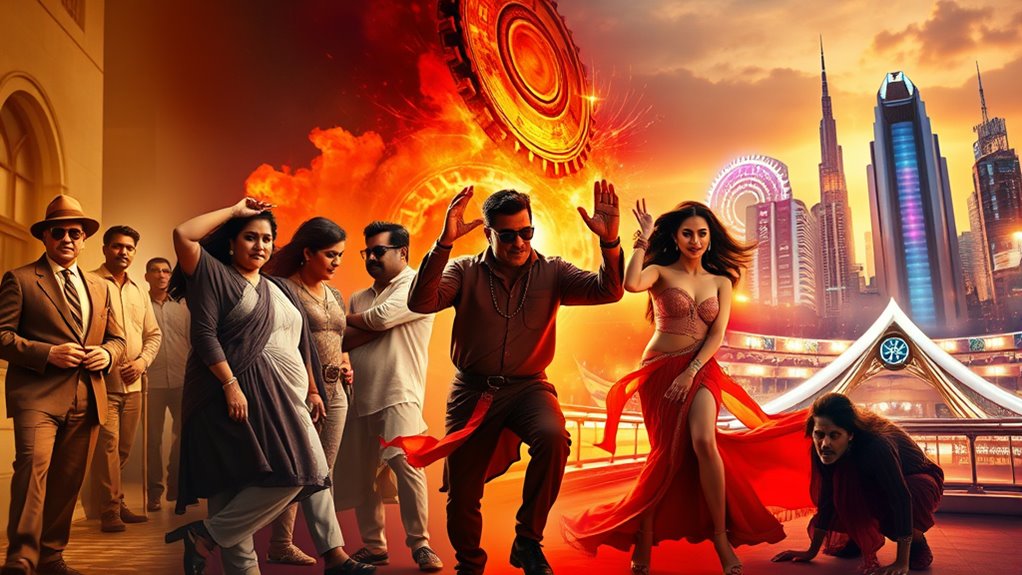
As Indian filmmaking continues to evolve, industry players are focusing on consolidating growth and expanding regional content to meet diverse audience preferences. You’ll see more regional cinemas like Tollywood and Mollywood thriving at the box office, reflecting a broader demand for local stories. Immersive content, powered by advanced visual effects and emerging technologies like VR and AR, will transform how you experience films. Streaming platforms are reshaping distribution, making Indian films accessible globally and encouraging collaborations with international partners. Meanwhile, Bollywood is in a rebuilding phase, aiming for a stronger release calendar in 2025 and 2026. Overall, the industry’s future lies in innovation, diversification, and strategic adaptation to evolving audience expectations and technological advancements.
The Enduring Legacy and Global Appeal of Bollywood
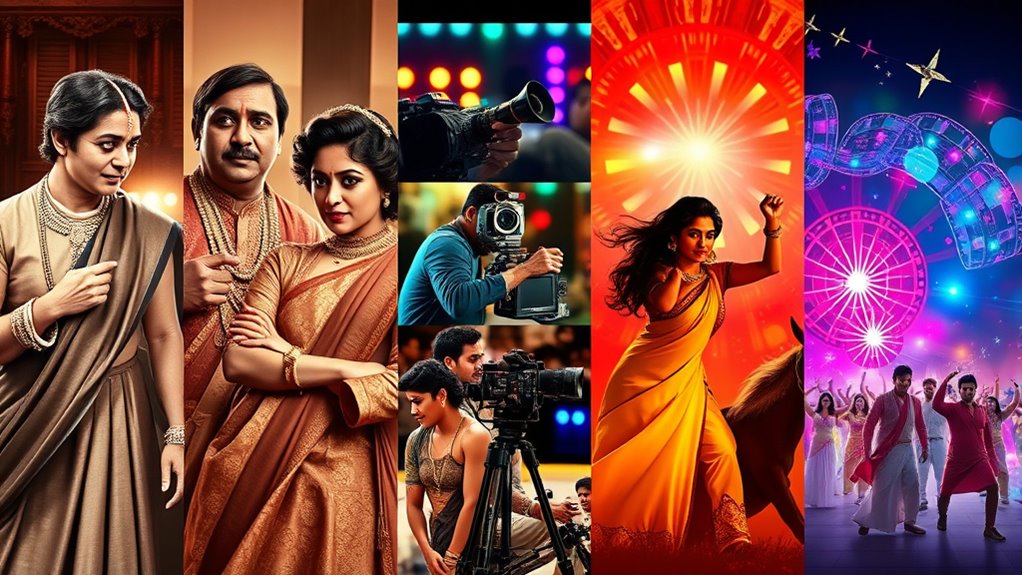
You can’t ignore how Bollywood has gained international recognition through awards and festivals, showcasing its global influence. Its vibrant music and storytelling have inspired audiences worldwide, making it a cultural phenomenon beyond India. Long-running hit films continue to resonate, solidifying Bollywood’s enduring legacy and widespread appeal.
Global Recognition and Awards
- Indian films regularly compete at Cannes, Venice, and Berlinale, earning awards and recognition.
- Bollywood actors such as Shah Rukh Khan and Amitabh Bachchan have received honors across continents.
- Film scores by composers like A. R. Rahman have won Oscars and Golden Globes, amplifying Bollywood’s musical influence.
Cultural Influence Worldwide
Bollywood’s global influence extends far beyond its acclaimed awards and international recognition, shaping cultures and perceptions worldwide. Your exposure to Bollywood’s vibrant films, music, and dance helps foster cross-cultural understanding and appreciation. Indian diaspora communities in the US, UK, Canada, Australia, and the Middle East drive demand, hosting festivals and screenings that celebrate this rich culture. Digital platforms like Netflix, YouTube, and social media make Bollywood accessible to audiences without large Indian communities, spreading its appeal globally. Bollywood’s lively musicals and dance styles inspire Hollywood productions and influence emerging cinema cultures across Southeast Asia and Africa. As a cultural soft power, Bollywood reshapes perceptions of India, promoting modernity, diversity, and vibrant traditions, and inspiring fashion, festivals, and artistic collaborations worldwide.
Long-Running Popular Films
- Iconic films foster cult followings, engaging multiple generations and shaping popular culture.
- Their success helps sustain regional cinemas and single-screen theaters for decades.
- Memorable songs, dialogues, and star power contribute to their legendary status and international recognition.
These films aren’t just entertainment; they’re cultural landmarks that amplify Bollywood’s global reach and legacy.
Frequently Asked Questions
How Did Silent Films Influence Indian Storytelling Techniques?
Silent films greatly influenced Indian storytelling by emphasizing visual expression over dialogue. You notice how exaggerated gestures, facial expressions, and symbolic imagery conveyed complex emotions and themes without sound. Intertitles, mime, and theatrical techniques made stories accessible across regions. This approach helped filmmakers develop universal narratives, introduced innovative visual effects, and set a foundation for integrating music and cultural themes, shaping India’s rich cinematic language for generations.
What Technological Challenges Were Faced During the Transition to Sound?
You might think shifting to sound was easy, but it was quite challenging. You faced installing new sound recording equipment in studios and theaters, often importing foreign technology and specialists. Reorganizing production systems, training actors with vocal skills, and updating theaters added complexity. Costs soared, and new roles emerged, like sound engineers and dialogue writers. This technological shift demanded innovation, reshaping the film industry and paving the way for Bollywood’s modern sound and musical storytelling.
Which Films Marked the Peak of Bollywood’s Golden Age?
You’re curious about the films that marked Bollywood’s golden age peak. During this era, movies like *Mother India* (1957), *Shree 420* (1955), and *Mughal-e-Azam* (1960) became iconic, showcasing social themes, grandeur, and storytelling excellence. These films not only achieved commercial success but also deeply influenced Indian cinema’s cultural landscape, setting standards for future generations and cementing the era’s legacy as a golden period in Bollywood history.
How Has Digital Technology Transformed Modern Bollywood Filmmaking?
You might think Bollywood’s magic relies solely on song and dance, but digital tech has revolutionized filmmaking. It cuts costs, speeds up production, and makes high-quality visuals accessible to indie filmmakers. With CGI, VFX, and digital distribution, your stories become more immersive and widespread. Social media connects you directly with fans, while cloud-based tools streamline collaboration. Digital transforms Bollywood into a dynamic, innovative industry where creativity knows no bounds.
What Future Innovations Are Expected to Shape Bollywood’S Global Reach?
You’ll see Bollywood’s global reach grow thanks to future innovations like increased streaming and digital distribution, making films accessible worldwide. VR and AR will enhance viewing experiences, while 3D and IMAX formats will captivate international audiences. Collaborations, international locations, and cross-cultural stories will boost global appeal. Plus, digital music, global marketing strategies, and partnerships with international studios will help Bollywood connect deeply with fans around the world.
Conclusion
As you reflect on Bollywood’s journey, it’s like watching a vintage film reel come to life—transforming silent whispers into vibrant, thunderous applause. From its silent beginnings to today’s blockbuster spectacles, you see how innovation and culture blend seamlessly. The industry’s future promises even more dazzling scenes, echoing its rich legacy. Just as a classic film remains timeless, Bollywood’s magic endures, enthralling hearts around the globe, proving that its story is far from over.
